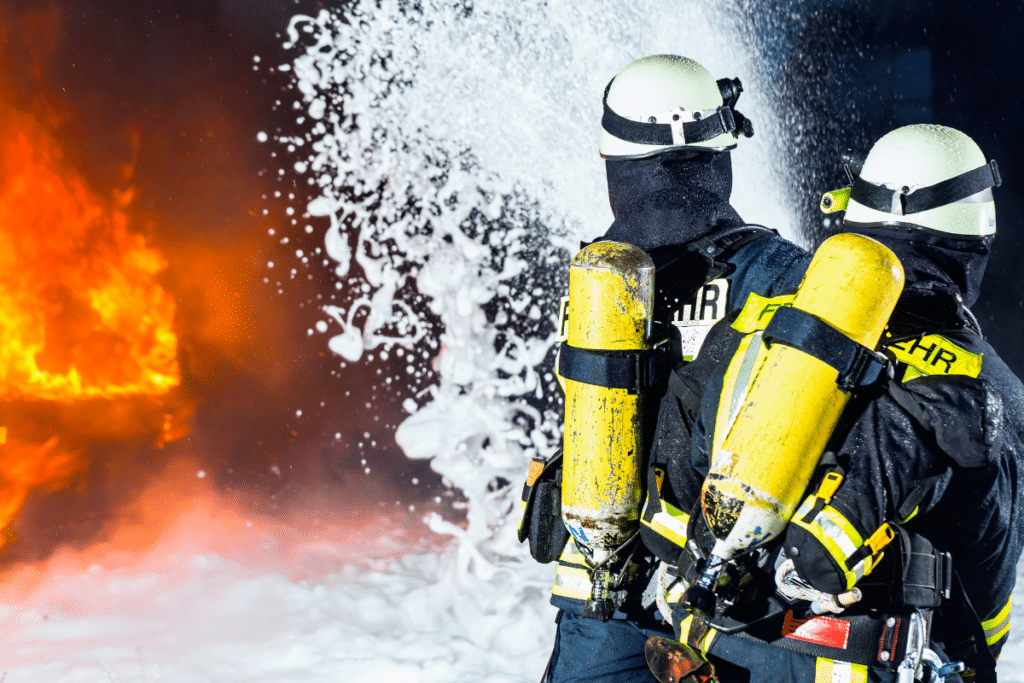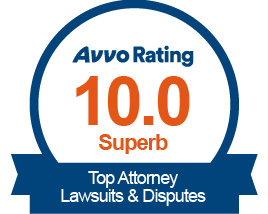AFFF Firefighting Foam Lawsuit
If you or your loved one has ever worked with AFFF and contracted cancer or another serious disease, our class action lawsuit attorneys can pursue substantial compensation for you through an AFFF lawsuit.

Workers who have handled class B firefighting foam, known as aqueous film-forming foam or AFFF, have been exposed to dangerous PFAS chemicals. PFAS chemicals have been linked to devastating cancerous and non-cancerous health conditions. Victims of AFFF exposure are filing lawsuits throughout the country alleging that AFFF manufacturers continued using PFAS chemicals in fire-fighting foam for decades after they knew PFAS chemicals were dangerous without warning the public.
Quick Links
- What Is AFFF?
- Who Is Affected By Firefighting Foam?
- What Health Problems Are Linked to PFAS in Firefighting Foam?
- Who Is Eligible to File an AFFF Firefighter Foam Lawsuit?
- Who Is Liable for PFAS Exposure in AFFF
- What Compensation Is Available in an AFFF Firefighting Foam Lawsuit?
- How Much Does It Cost to File an AFFF Lawsuit?
- How Can the Firefighting Foam Lawyers at Cutter Law Help Me?
- Contact Cutter Law Today
What Is AFFF?
AFFF is a chemical foam used to suppress Class B fires, which are those fueled by flammable liquids like gasoline, alcohol, or oil. AFFF is activated when mixed with water. It forms a film that blocks oxygen and essentially suffocates the fire.
AFFF was first manufactured in the late 1960s. Thousands of PFAS chemicals are used in various products, but the primary PFAS chemicals in AFFF are perfluorohexane sulfonate, or PFHxS, and perfluorooctane sulfonate, or PFOS.
PFAS are also known as forever chemicals because they do not break down in the environment or the human body. Over time, the level of PFAS in your body accumulates, potentially reaching high levels and increasing the risk of cancer with repeated exposure.
Who Is Affected By Firefighting Foam?
The workers most likely to be exposed to AFFF are:
- Firefighters
- Military personnel
- Airport workers
- Chemical plant workers
- Waste disposal workers
- Petroleum refinery workers
- Workers who manage bulk storage facilities
PFAS chemicals typically enter the body when workers inhale contaminated dust, consume food or water in areas near where AFFF was used, and drink contaminated water.
Firefighters
A 2019 study by the IPEN Panel of Independent Experts found unacceptable levels of PFAS chemicals in the blood of firefighters who had direct exposure to AFFF. Firefighters may be exposed to AFFF while doing the following:
- Suppressing fires
- Participating in fire suppression training activities
- Cleaning up or disposing of AFFF
- Wearing personal protective equipment contaminated with AFFF
- Using contaminated equipment
- Working in firehouses where contaminated dust and soil residues are present
Testing has revealed that even low levels of exposure over a short period can lead to unacceptable levels in blood test results.
Military Personnel
The U.S. military is the largest user of AFFF in the world. The military has historically used it for training and fire-fighting, especially on aircraft and Navy ships. The United States Navy patented AFFF in the 1960s and started requiring its use on all Navy ships in 1967 after a fire killed 34 sailors.
The military used a specific grade of AFFF known as MILSPECT AFFFF, which was rated to extinguish fires within 50 seconds, as opposed to the 180-second standard in civilian AFFF. By the 1970s, the Department of Defense had learned that PFAS in firefighting foam was dangerous but did nothing to limit its use or minimize its risks.
Airport Workers
Airport workers were exposed to AFFF firefighting foam when suppressing aircraft fires, training, and testing equipment. In some training exercises, entire hangars were flooded with AFFF.
Chemical Manufacturing Workers
Chemical manufacturing companies often store AFFF on-site and use it to suppress fires involving flammable liquids. Workers can also be exposed while manufacturing AFFF.
Waste Disposal Workers
Workers responsible for disposing of firefighting foam may be exposed to PFAS while cleaning up the site. They can also be exposed while disposing of storage materials or other materials that came into contact with AFFF.
Petroleum Refinery Workers
AFFF is highly effective in suppressing fires caused by flammable liquids. Petroleum refineries usually store large amounts on-site due to the high risk of Class B fires and explosions in their facilities. Petroleum refinery fires are often quite large, resulting in the potential for a large release of AFFF in the event of a fire.
Bulk Storage Facilities
Workers in facilities that store AFFF may be exposed to PFAS when they fill or empty storage tanks or while cleaning, maintaining, or disposing of the tanks. They experience a high risk of exposure from a leak or spill. Old or poorly maintained underground storage tanks can slowly leech PFAS into the soil and groundwater. Workers may be exposed when they drink the water or inhale the dust.
What Health Problems Are Linked to PFAS in Firefighting Foam?
PFAS in AFFF has been linked to numerous cancerous and non-cancerous conditions, as shown below.
Cancerous Conditions | Non-Cancerous Conditions |
Kidney cancer | Reduced fertility |
Testicular cancer | Pregnancy complications |
Breast cancer | Developmental effects in children |
Female reproductive cancers | Behavioral changes in children |
Prostate cancer | Immune system impairments |
Thyroid cancer | Hormone disruption |
Non-Hodgkin lymphoma | Increased cholesterol |
Childhood leukemia | Obesity |
PFAS in firefighting foam can leech into the groundwater and contaminate drinking water. The CDC estimates that over 99 percent of the population has been exposed to PFAS in drinking water, and AFFF is one of the main sources of contamination.
Who Is Eligible to File an AFFF Firefighter Foam Lawsuit?
You may be eligible to file an AFFF foam lawsuit if you meet the following criteria:
- You have been exposed to AFFF through your occupation or drinking water.
- You have been diagnosed with cancer.
- Your AFFF exposure caused your condition.
Our knowledgeable personal injury lawyers can review your diagnosis and life history to determine your eligibility.
Who Is Liable for PFAS Exposure in AFFF
The following manufacturers have produced AFFF and supplied it to employers and the military:
- Dupont and its spin-off company Chemours
- 3M
- AGC Chemicals Americas
- National Ford Chemical Company
- Raytheon Technologies Corporation
- Tyco Fire Products LP and its subsidiary Chemguard
- Ansul
- Atofina
- Buckeye
- Dynax
- Kidde
This is not an exhaustive list.
Despite knowing the chemicals in AFFF were dangerous, these companies failed to warn the public and continued manufacturing and selling the products. Three of the largest companies, DuPont, Chemours, and 3M, recently settled a class action PFAS water contamination lawsuit alleging chemicals in AFFF contaminated drinking water supplies. The companies have agreed to pay over $10 billion to aid cleanup efforts.

“PFAS are dangerous chemicals with a proven link to multiple cancers. Manufacturers have failed to take the necessary steps to get them out of their products and to remediate sites where they have been dumped.”
What Compensation Is Available in an AFFF Firefighting Foam Lawsuit?
If you have been diagnosed with a condition as serious as cancer, you deserve significant compensation for your financial and emotional losses. Our compassionate and skilled AFFF attorneys can help you pursue the following economic and non-economic damages:
- Medical expenses
- Lost wages
- Pain and suffering
- Loss of society
- Emotional distress
If your loved one has died of cancer from exposure to PFAS in firefighting foam, we can help you pursue damages, including compensation for your loss of companionship, lost inheritance, loss of your loved one’s income, and your loved one’s final expenses.
How Much Is My AFFF Foam Cancer Lawsuit Worth?
AFFF lawsuit settlement amounts vary based on the unique facts of your case. If you have developed terminal cancer from exposure or your loved one has died, you could receive compensation ranging from six to seven figures. We have recovered hundreds of millions in settlements and verdicts and are committed to ensuring you are compensated fairly for the harm you have suffered.
How Much Does It Cost to File an AFFF Lawsuit?
When you choose Cutter Law, we will handle your AFFF lawsuit with no upfront costs to you. We work on a contingency fee basis, meaning we take on all the risks and costs of your lawsuit. We will collect our fees and costs from the compensation we recover for you. If we do not recover compensation, you owe us nothing.
How Can the Firefighting Foam Lawyers at Cutter Law Help Me?
When you have our compassionate and skilled class action lawsuit attorneys on your side, you can count on us to handle every aspect of your claim with compassion, skill, and integrity. We lead with compassion and do the following when you are our client at Cutter Law:
- Advise you of your legal options
- Investigate your exposure and determine who is responsible
- Gather evidence to prove the defendant’s liability
- Consult experts to build your case
- Analyze your medical records and calculate your damages
- File your AFFF firefighting foam lawsuit
- Negotiate a settlement and refuse to accept less-than-fair compensation
- Take your case to trial if necessary
- Welcome your calls, answer your messages, and go out of our way to keep you informed
We are a family-owned law firm, and our attorneys work together on every case. Unlike large corporate firms that assign you to one attorney, you will benefit from the strengths and experience of all of our attorneys. We have over 130 years of combined experience and hundreds of satisfied clients.
Contact Cutter Law Today
If you or your loved one has been diagnosed with cancer and you were exposed to AFFF firefighting foam during your lifetime, you may be entitled to substantial compensation. As a family-focused law firm, we understand how much your family means to you. We are committed to your whole family while we fight fervently and effectively for the compensation you deserve.
Contact us today to schedule your free case review.
Testimonials
Schedule A Free Case Review
"*" indicates required fields
Our Office Locations
Sacramento Office
401 Watt Avenue Suite 100
Sacramento, CA 95864
Phone: 916-290-9400
Oakland Office
Cutter Law P.C.
1999 Harrison Street Suite 1400
Oakland, CA 94612






